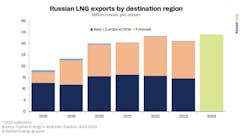Brent crude oil prices on London’s International Commodity Exchange fell in July on higher global output, while West Texas Intermediate crude prices on the New York Mercantile Exchange rose on strong US refining and exports. Both benchmarks are up 50% year-over-year. The Brent-WTI differential in July narrowed sharply vs. June.
In its latest Oil Market Report, the International Energy Agency’s global demand growth outlook for this year is unchanged at 1.4 million b/d.
However, the solid level of demand growth is heavily influenced by demand in this year’s first quarter when growth was more than 1.8 million b/d, mainly due to low temperatures in the northern hemisphere.
According to IEA, the pace of global demand growth has slowed dramatically to a relatively subdued 1 million b/d in this year’s second and third quarter, partly because of comparisons with high year-ago demand levels and because prices—based on Brent crude—have typically been about 45% higher.
In the Organization for Economic Cooperation and Development’s European members, oil demand in the second quarter fell below last year, and in the US, falling gasoline demand has contributed to more than the halving of total demand growth in the second quarter from a year ago.
The two leading non-OECD oil markets, China and India, both remain on course to grow solidly this year, although data issues with respect to China cloud the picture to some extent. Meantime, some developing countries are taking steps to shield consumers from higher prices. An example is Indonesia where plans are being made to increase sharply subsidies to maintain diesel and gasoline prices at current levels.
In this year’s fourth quarter, IEA expects a rebound and demand will be 100.2 million b/d.
In 2019 growth has been revised up, accelerating slightly to 1.5 million b/d, partly influenced by the downward move of the forward price curve. However, IEA emphasizes there are risks to the forecast from escalating trade disputes and rising prices if supply is constrained.
“The risks to stable supply that will grow later this year could cause higher prices and thus impact demand growth. Another factor to consider is that trade tensions might escalate and lead to slower economic growth, and in turn lower oil demand.”
The International Monetary Fund, in its recent World Economic Outlook Update, said, “The balance of [economic] risks has shifted further to the downside, including in the short term.” For now, IEA has made no changes to its underlying economic and oil demand assumptions, but demand growth could cool down later this year and into 2019. If this does happen, it might dampen to some extent the impact on prices of any supply pressures.
Supply
Global oil supply rose by 300,000 b/d in July to 99.4 million b/d, 1.1 million b/d above a year-ago. OPEC crude oil output was steady in July, at 32.18 million b/d. An unexpected decline in Saudi Arabian supply was offset by higher production from the UAE, Kuwait and Nigeria. OPEC compliance was unchanged in July at 121%. Compliance with the Vienna Agreement eased to 97% in July as output cuts were relaxed.
Non-OPEC production is expected to grow by 2 million b/d in 2018 and by 1.85 million b/d next year.
According to IEA, concerns about the stability of oil supply have cooled down somewhat, at least for now.
“We have seen increases in production, mainly in Saudi Arabia and Russia, a surge in US exports in June that saw a record weekly average level of 3 million b/d, and a partial, but fragile, recovery in Libya. Ample supply has contributed to the Brent price falling from just over $79/bbl at the end of June to below $72/bbl earlier this week. This cooling down in prices is clearly welcome for consumers: the biggest single product market in the world is US gasoline and the national average price increase seen during the spring seems to have stalled for the time being,” IEA said.
However, the recent cooling down of the market, with short-term supply tensions easing, currently lower prices, and lower demand growth might not last.
“When we publish our next report in mid-September, we will be only 6 weeks away from the US’s deadline for Iran’s customers to cease oil purchases. As oil sanctions against Iran take effect, perhaps in combination with production problems elsewhere, maintaining global supply might be very challenging and would come at the expense of maintaining an adequate spare capacity cushion. Thus, the market outlook could be far less calm at that point than it is today,” IEA said.
Stocks, throughputs
OECD commercial stocks fell seasonally by 7.2 million bbl in June to 2,823 million bbl and were 32 million bbl below the 5-year average. Stocks at the end of the second quarter were up 6.6 million bbl vs. the end of the first quarter—the first quarterly increase seen since first-quarter 2017. Outside the OECD, inventories also were mostly higher during the quarter.
Global refinery throughputs in the second half are expected to be 2 million b/d higher than in the first half. Due to high summer demand, refined products stocks will draw down before building again in the fourth quarter. The outlook will be heavily influenced by Iranian crude flows and resulting changes to crude prices and margins.

